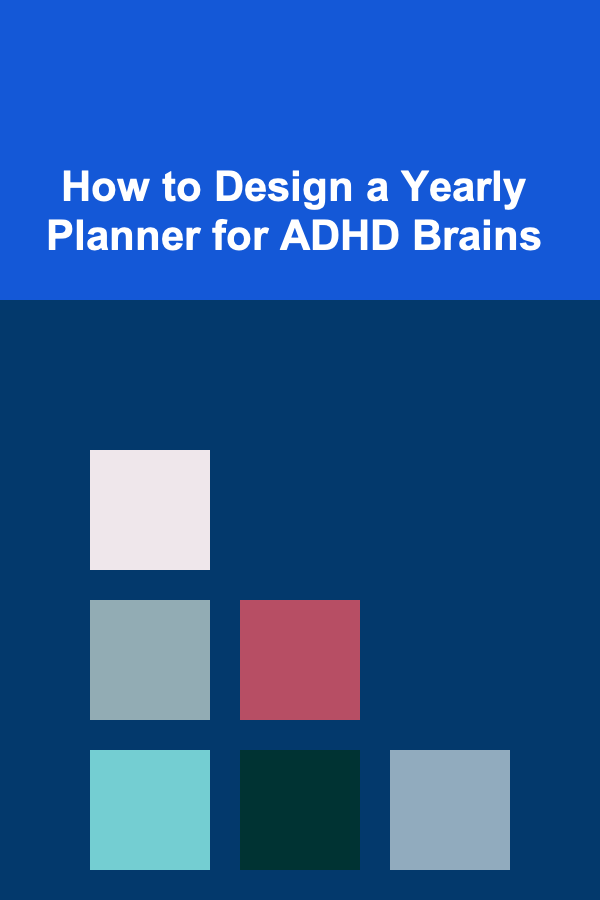
How to Design a Yearly Planner for ADHD Brains
ebook include PDF & Audio bundle (Micro Guide)
$12.99$6.99
Limited Time Offer! Order within the next:

Designing a yearly planner tailored to the needs of individuals with ADHD (Attention Deficit Hyperactivity Disorder) is a thoughtful and essential undertaking. ADHD can make it challenging to stay organized, follow through on tasks, and maintain focus on long-term goals. A planner that is carefully constructed to accommodate the unique characteristics of ADHD can help individuals better manage their time, stay motivated, and boost their productivity. This article explores the key considerations and steps involved in creating a yearly planner designed specifically for ADHD brains, ensuring it's not only functional but also engaging and empowering.
Understanding ADHD and Its Impact on Organization
Before diving into the specifics of designing a planner, it's important to understand the challenges that individuals with ADHD face when it comes to organization and time management. ADHD is a neurodevelopmental disorder that affects attention, impulse control, and executive functions like planning and organizing. As a result, individuals with ADHD may experience:
- Difficulty focusing on tasks: This can lead to procrastination, incomplete projects, and missed deadlines.
- Time blindness: People with ADHD may have difficulty estimating how much time is passing, leading to poor time management.
- Disorganization: Juggling multiple tasks and responsibilities can create chaos, resulting in scattered thoughts and cluttered environments.
- Difficulty prioritizing: With so many things on their mind, individuals with ADHD may struggle to determine which tasks are the most important.
- Forgetfulness: Simple tasks like remembering appointments, deadlines, or essential information can slip through the cracks.
Given these challenges, a yearly planner designed for ADHD needs to be more than just a calendar; it must be an intuitive, interactive tool that helps individuals with ADHD stay organized, focused, and motivated throughout the year.
Key Features of a Yearly Planner for ADHD
A successful planner for ADHD brains should incorporate several core features that cater to their needs. These features should be designed to encourage consistent use, provide structure, and reduce overwhelm.
2.1. Clear and Simple Layout
People with ADHD often struggle with overwhelming information. A cluttered, overly complex planner can contribute to stress and frustration. Therefore, the layout should be clear, simple, and easy to navigate.
- Minimalistic Design: Use a clean design with ample white space. Avoid excessive colors or complicated patterns that can distract or overwhelm the user.
- Sectioned Pages: Organize the planner into distinct sections, such as monthly, weekly, and daily views. Having a dedicated space for each type of planning helps keep things structured and easy to follow.
2.2. Visual Cues and Color Coding
Color can be a powerful tool for individuals with ADHD, as it can help with prioritization and focus. Visual cues, such as color-coded sections and symbols, make the planner more intuitive.
- Color Coding Tasks: Assign colors to tasks based on their importance or urgency. For example, use red for high-priority tasks, yellow for medium-priority tasks, and green for low-priority tasks.
- Symbolic Icons: Incorporate visual symbols (e.g., exclamation marks, stars, checkboxes) next to tasks to provide quick visual cues. This helps highlight important information at a glance and makes the planner more engaging.
2.3. Chunking Information
Breaking down large tasks into smaller, manageable chunks is essential for those with ADHD, as it reduces overwhelm and increases the likelihood of completion.
- Task Breakdown: For major tasks or goals, include sections that prompt users to break them down into smaller steps or action items. This encourages progress and helps with task initiation.
- Mini-Deadlines: Incorporate mini-deadlines or intermediate milestones for larger tasks, which keeps the user on track and provides a sense of accomplishment as they progress.
2.4. Flexible Structure
Individuals with ADHD often experience fluctuating motivation and energy levels, so the planner should be flexible enough to accommodate these changes.
- Daily, Weekly, and Monthly Views: Allow for both long-term and short-term planning. While yearly goals are important, having a detailed view of the month, week, and day ensures that the user can track immediate tasks while keeping the bigger picture in mind.
- Spontaneity Sections: Include "free" or "buffer" sections that give space for tasks that may pop up unexpectedly. This allows users to adjust and reprioritize when needed.
2.5. Incorporating Reminders
Given that ADHD often leads to forgetfulness, reminders are a crucial part of any ADHD-friendly planner. These should be clearly visible and easy to implement.
- Task Reminders: Add boxes or checkmarks that prompt users to follow up on tasks or commitments. Having a dedicated space to check off completed items provides a sense of accomplishment.
- Priority Reminders: Highlight the most urgent or important tasks to ensure they don't get overlooked. Use bold text or color to make these reminders stand out.
2.6. Reflection and Review Sections
Reflection is an important part of ADHD management, as it helps individuals recognize their progress, identify challenges, and make adjustments. Including spaces for reflection allows users to track their behavior and improve over time.
- End-of-Week/Month Reflection: Include questions or prompts to encourage users to reflect on what they achieved, what worked well, and where they need improvement. This can help individuals identify patterns and set more realistic goals in the future.
- Habit Trackers: ADHD often involves challenges with building habits. Include habit trackers that allow users to monitor their consistency with specific habits, such as taking breaks, exercising, or meditating.
Choosing the Right Format: Digital vs. Paper Planners
When designing a yearly planner for ADHD, one of the key decisions is whether to opt for a digital or paper planner. Each format has its pros and cons, so it's important to choose the one that best fits the individual's needs and preferences.
3.1. Paper Planners
Paper planners can offer a tangible, hands-on experience, which is beneficial for many individuals with ADHD.
-
Pros:
- Tactile Interaction: Writing things down on paper can help individuals internalize tasks better, providing a sense of accomplishment as they physically check off completed tasks.
- Limited Distractions: Unlike digital devices, paper planners don't have the distractions of social media, notifications, or other apps, making them ideal for focusing on tasks.
-
Cons:
- No Automatic Reminders: Unlike digital planners, paper planners don't have built-in reminders or alerts. However, this can be mitigated by incorporating manual reminder systems, such as sticky notes or alerts.
- Less Flexibility for Updates: If tasks or schedules change frequently, it can be harder to modify a paper planner. Some people find this restrictive.
3.2. Digital Planners
Digital planners offer a range of benefits, especially for people who prefer using technology or need access to their planner across multiple devices.
-
Pros:
- Built-In Reminders and Alerts: Digital planners can send automatic reminders or notifications for upcoming tasks and deadlines.
- Syncing Across Devices: Users can access their planner from multiple devices, such as smartphones, tablets, and computers, which ensures they always have their schedule on hand.
- Customizability: Digital planners can be easily customized with apps that support habit tracking, goal setting, and task management.
-
Cons:
- Distractions: Digital planners can be prone to distractions, such as social media or app notifications. However, using apps with minimal notifications or using "Do Not Disturb" features can help manage this.
- Screen Fatigue: Constant screen use can lead to fatigue or difficulty focusing for some individuals, making paper planners a better option in these cases.
Ultimately, the decision between a digital or paper planner depends on personal preference, lifestyle, and the individual's ability to manage digital distractions.
Setting Realistic Goals and Expectations
For a planner to be effective for someone with ADHD, it is essential to set realistic, achievable goals. Having overly ambitious goals can lead to frustration, whereas manageable goals build momentum and confidence.
- SMART Goals: Use the SMART (Specific, Measurable, Achievable, Relevant, Time-Bound) goal framework when setting yearly goals. This approach ensures that goals are clear and broken down into actionable steps.
- Quarterly Reviews: Break the year into smaller sections (quarters) to evaluate progress. Instead of focusing solely on yearly goals, quarterly reviews provide a more tangible timeline and allow for adjustments when necessary.
Incorporating ADHD Strategies and Tips Into the Planner
The final step in designing an ADHD-friendly planner is integrating proven strategies that will help individuals with ADHD manage their time and tasks effectively. Here are some tips that can be incorporated into the planner:
5.1. Time Blocking
Encourage users to divide their day into blocks of time dedicated to specific tasks. This structured approach reduces the chances of task overload and helps users stay on track.
5.2. Pomodoro Technique
Incorporate the Pomodoro technique, which involves working in focused intervals (typically 25 minutes) followed by short breaks. This method can help ADHD brains maintain focus without becoming overwhelmed.
5.3. Prioritization and Task Delegation
Help users prioritize tasks using the Eisenhower Matrix or ABCDE method. These systems teach users to categorize tasks based on urgency and importance, reducing the tendency to focus on trivial tasks at the expense of significant ones.
Conclusion
Designing a yearly planner for ADHD brains requires thoughtful consideration of the unique challenges individuals with ADHD face. A well-designed planner can empower users by providing them with a structure that is flexible, engaging, and conducive to focus and productivity. Key features such as visual cues, task breakdowns, reflection sections, and reminders can help individuals with ADHD manage their time effectively and stay on track with their goals. Whether digital or paper, the right planner can make all the difference in helping individuals with ADHD thrive in both their personal and professional lives.
Reading More From Our Other Websites
- [Home Maintenance 101] How to Identify and Treat Termites: A Homeowner's Guide to Termite Control
- [Home Budget 101] How to Achieve Your Financial Goals with a Detailed Home Budget: A Roadmap to Success
- [Home Space Saving 101] How to Install Corner Shelves for Living Room Functionality Without Damaging Your Walls
- [Home Staging 101] How to Blend Contemporary Trends with Classic Charm for Perfect Home Staging for a Traditional Style Residence
- [Home Security 101] How to Choose the Best Locks to Increase Your Home's Security
- [Organization Tip 101] How to Organize Souvenirs Without Cluttering Your Home
- [Home Security 101] How to Decide Between Wired and Wireless Security Systems: Pros and Cons
- [Mindful Eating Tip 101] Best Mindful Eating Exercises for People with Anxiety Who Feel Overwhelmed by Meal Prep
- [Organization Tip 101] How to Create a DIY Organization Project on a Budget
- [Personal Care Tips 101] How to Integrate a Razor into Your Daily Routine

A Guide to Utilizing Public Parks and Recreational Areas for Free Outdoor Fun
Read More
How to Make Money Online as a Data Entry Specialist: 10 Actionable Ideas
Read More
How to Use Jewelry Making to Make Money
Read More
How to Boost Your Mood While Losing Weight
Read More
Understanding the Governance of AI
Read More
How to Create a Fundraising Plan for a School
Read MoreOther Products

A Guide to Utilizing Public Parks and Recreational Areas for Free Outdoor Fun
Read More
How to Make Money Online as a Data Entry Specialist: 10 Actionable Ideas
Read More
How to Use Jewelry Making to Make Money
Read More
How to Boost Your Mood While Losing Weight
Read More
Understanding the Governance of AI
Read More